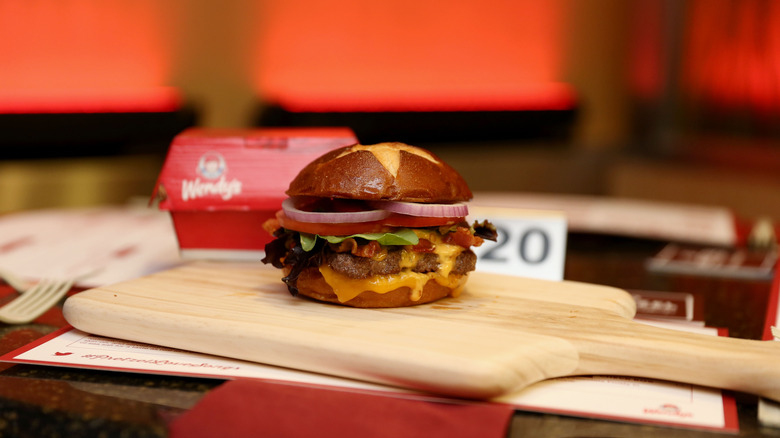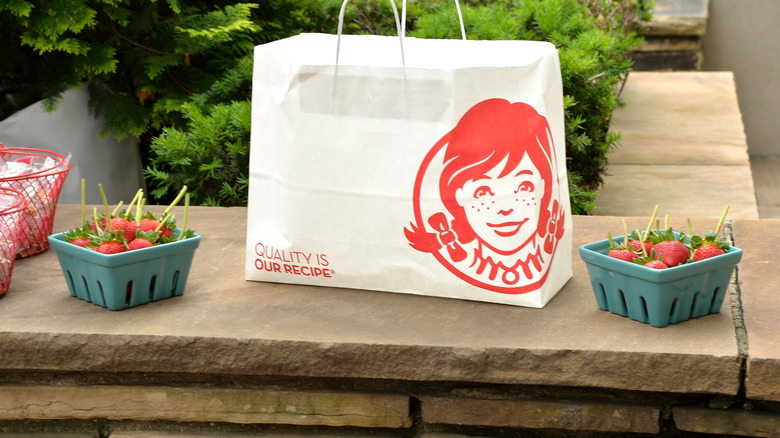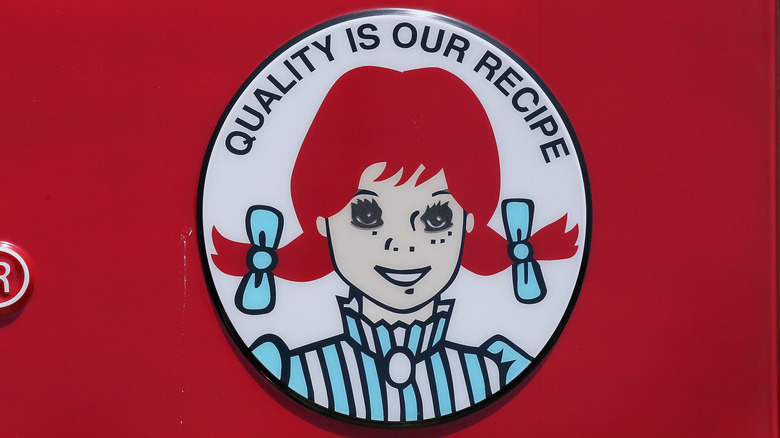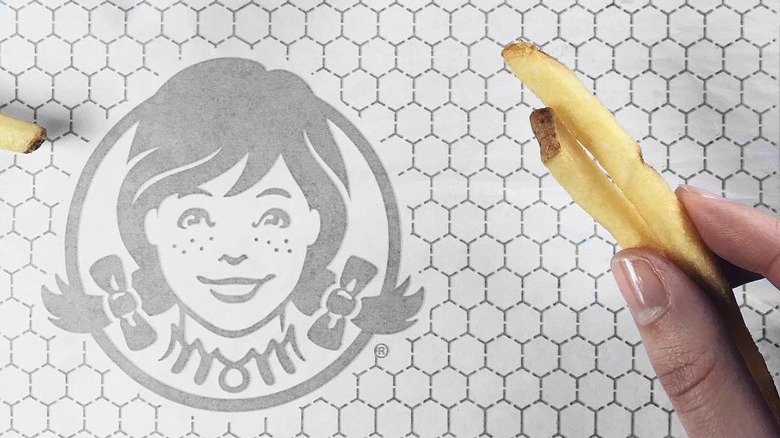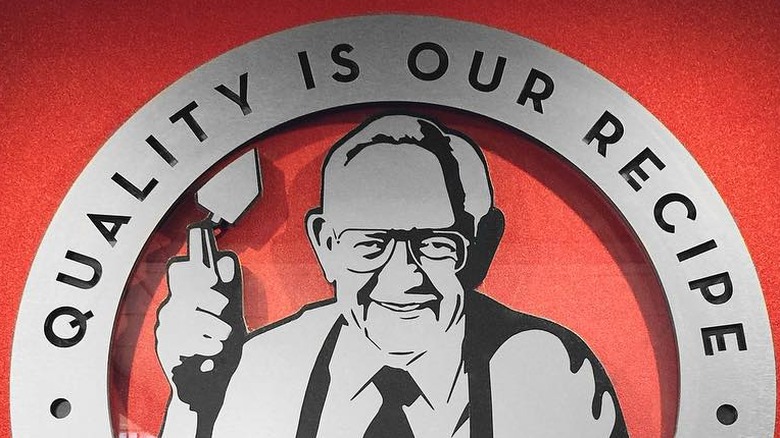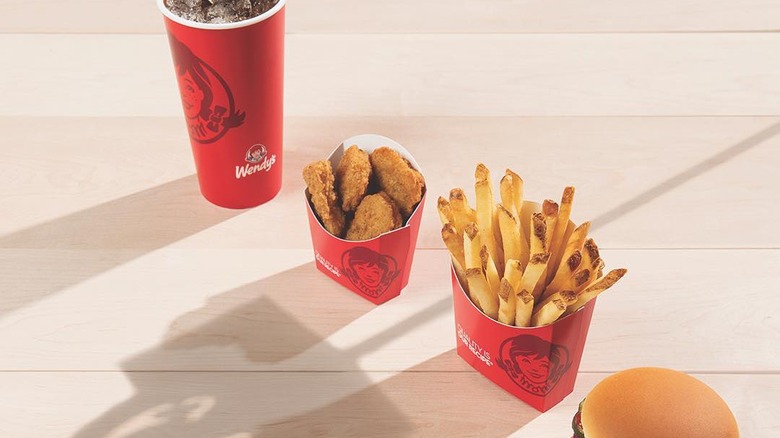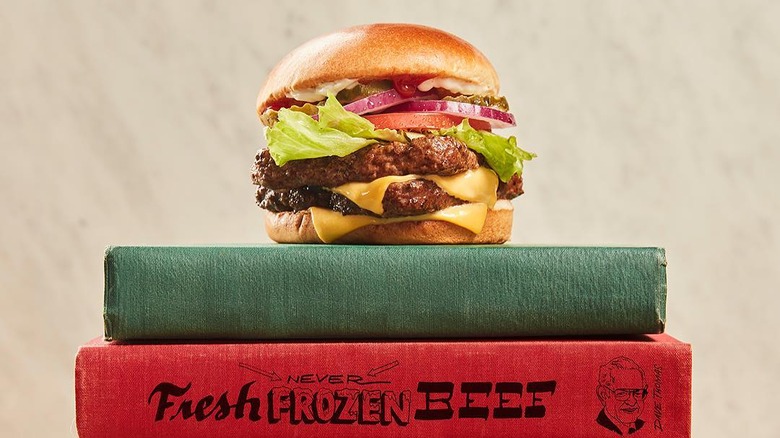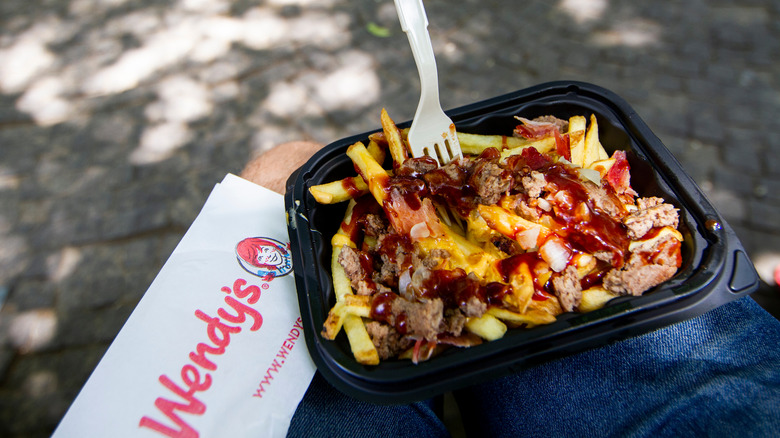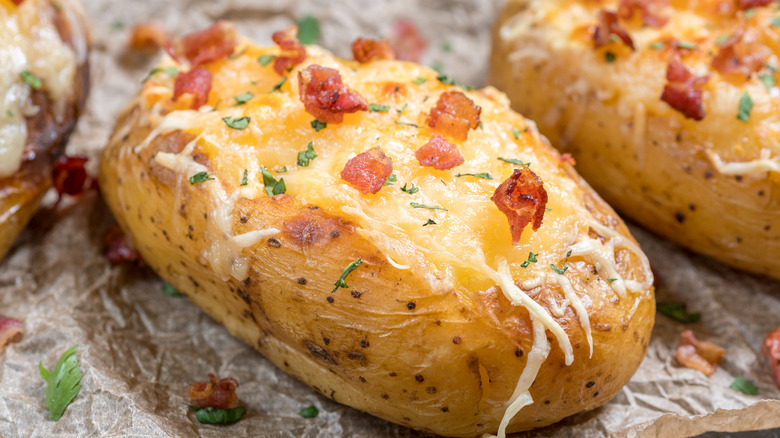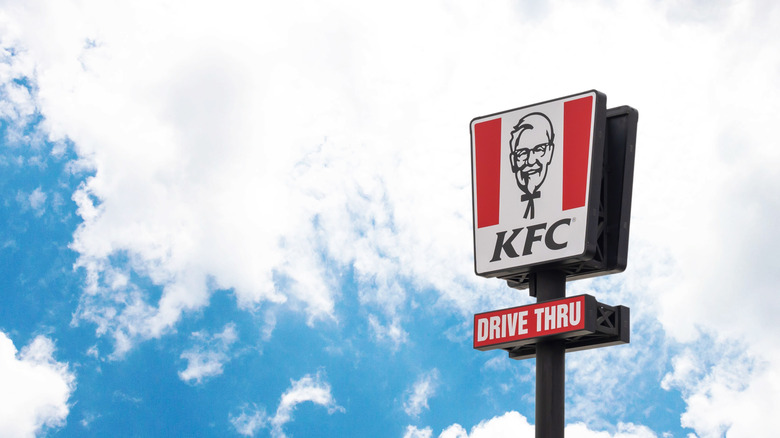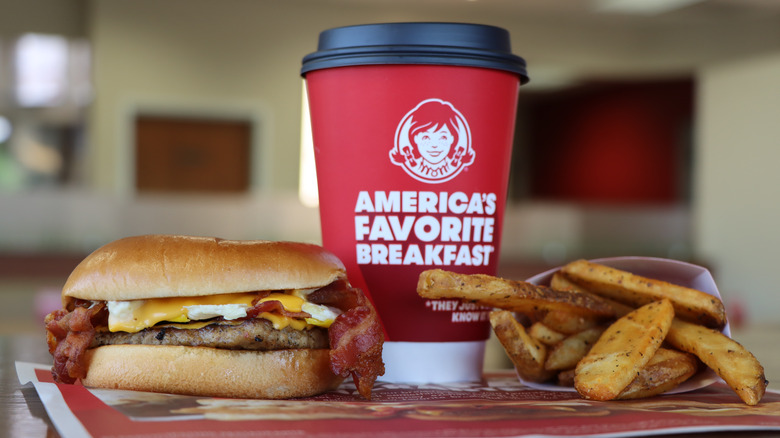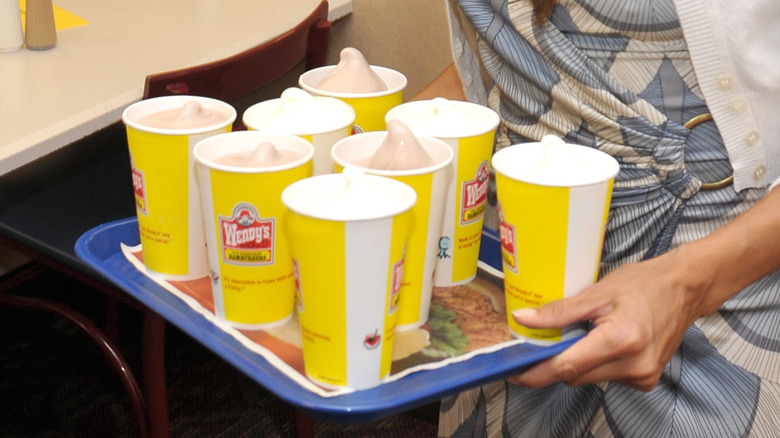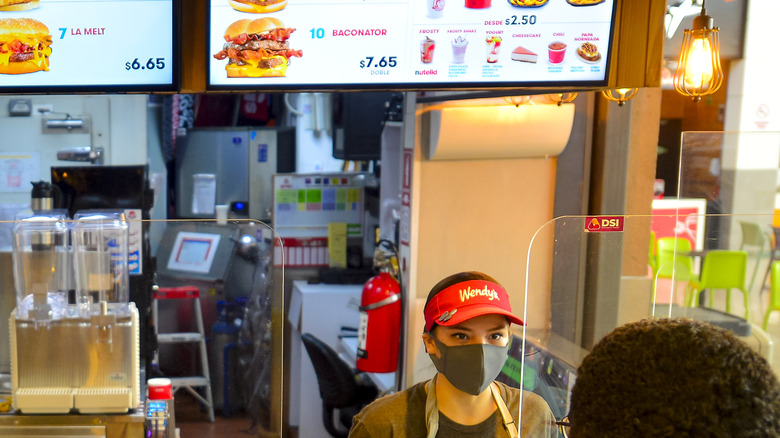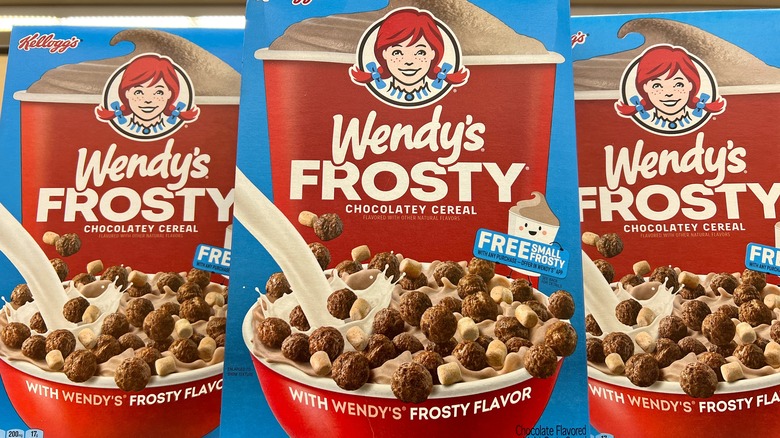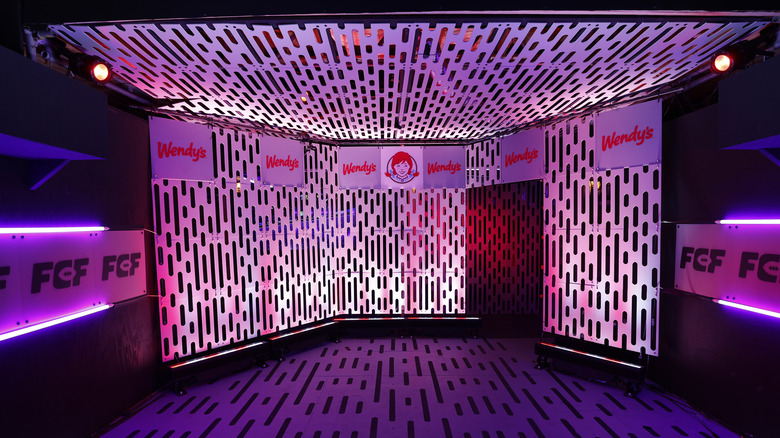The Untold Truth Of Wendy's
Wendy's has more than 6,500 international locations, making it the third-largest burger franchise in the world. Founded in 1969, today the company is worth billions and has become beloved by people all over the world who love their burgers and fries. The history behind the company's success is fascinating and inspiring, and will impress anyone — Wendy's fan or not. In fact, the story is compelling enough that it just might convince Wendy's haters to try a Dave's Double.
There's a secret menu at Wendy's
The special menu at Wendy's isn't exactly a well-kept secret, which is great for customers who want to try something a little out of the ordinary. If you're tired of chicken nuggets, check out some of the offerings on the secret menu. There's a one-pound Meat Cube burger and a Barnyard Burger which has beef, bacon, and chicken. A lot of secret menu items really pack on the protein, so for a lighter option, try the Valley Crispy Chicken Club sandwich.
The Wendy's Frosty has been around since day one
There are plenty of classic menu items to choose from at Wendy's, like the tried-and-true Frosty. This bad boy has been around since Wendy's was first founded in 1969. According to the official Wendy's website, founder Dave Thomas "wanted a dessert on the menu that was so thick you had to eat it with a spoon" and so the Frosty, "a cross between a milk shake and soft-serve ice cream" was born.
To keep the chocolate flavor from being too overwhelming, Thomas added vanilla to the recipe. The result was a sweet, chocolate treat that perfectly complemented a hamburger. While this chocolate/vanilla combo was the default Frosty flavor for decades, the vanilla Frosty was launched in 2006.
Wendy's grew much larger than founder Dave Thomas anticipated
When Wendy's was launched in 1969, there were just five items on the menu. His ideas for the restaurant resulted in criticism from some experts in the industry, so Dave Thomas didn't have great ambitions for the first Wendy's he opened in Columbus, Ohio (per Funding Universe). He simply wanted a small, local chain where his kids could work in the summers.
Despite his modest expectations, Thomas soon found himself with a successful business. He opened a second Wendy's after a year and by 1974, sales totaled at nearly $25 million. By the end of 1976, not even a decade since the company was started, there were 500 Wendy's locations.
The real-life Wendy was teased for being the face of the restaurant
Dave Thomas had four kids and knew one of them would become the face of the restaurant, but he wasn't playing favorites when he picked 8-year-old Melinda, nicknamed Wendy. "Dad wanted a name that was easy to remember, and he wanted an all-American mug," she told People in 1990. "I was redheaded and had freckles and buckteeth, so I got elected."
Wendy admitted to often being embarrassed because of her famous face."There was always teasing," she said. "It just goes with the territory."
The Wendy's logo has no secrets under its collar
A lot of people seem to think the modern Wendy's logo, redesigned in 2013, has a secret message hidden in it. In the picture, it looks like the word "mom" is hidden in Wendy's collar. While some thought this was a reference to a home-cooked meal just like Mom would make, it turns out the "hidden message" was just a coincidence.
"We are aware of this and find it interesting that it appears our Wendy cameo has 'mom' on her ruffled collar. We can assure you it was unintentional," said a spokesperson for the company.
Wendy's founder Dave Thomas was a high school dropout
The success of Wendy's is even more impressive when you look at the history of Dave Thomas. A high school dropout, Thomas served in the Korean War before becoming a cook. He went on to work at Kentucky Fried Chicken, where he came up with the idea for the KFC chicken bucket. After climbing through the ranks, Thomas left the company in 1969 and founded Wendy's. The rest is history.
After Wendy's became a success, a 61-year-old Thomas went back to school to earn his GED. He then founded the Dave Thomas Education Center to help other high school dropouts earn their GEDs, as well.
Wendy's was the first restaurant to launch a value menu
Many fast food restaurants these days have value menus which offer items at a lower price. Wendy's was the first to utilize this now-popular concept, launching the first value menu in 1989, nearly a decade before Burger King got on the value menu train in 1998.
Denny Lynch, the senior VP of communications for Wendy's, explained why the company decided to offer menu items at a discounted price. "At that time, all of the hamburger chains were going after each other and it escalated to the point where we were seeing 99-cent Whoppers and Big Macs," he said. "These prices were on permanent signage, they weren't being done as a limited-time promotion. From (Wendy's) perspective, the market share battles were so intense that chains were discounting their flagship items."
To compete with other restaurants lowering prices on key menu items, the Wendy's value menu was created. "We had the idea of rather than selling one of our big items at 99 cents, creating a whole menu with 99-cent items," said Lynch. "We wanted our customers to be able to make a full meal with these lower-priced items."
There's a good reason the burger patties at Wendy's are square
Wendy's is noted for the unusual shape of its hamburger patties. There's a good reason the patties are square instead of round. Thomas got the idea for the square patties from a Michigan restaurant called Kewpee Burger, which served square-shaped patties. Thomas decided to incorporate these patties so customers could easily see the freshness of the meat. The corners of the square patties stick out past the circular bun, making it easy to see the juiciness of the meat.
The Wendy's 'Where's the beef?' lady was fired
Wendy's launched a series of memorable commercials in the 1980s featuring a woman whose catch phrase "Where's the beef?" would become famous. The commercials were so successful that Wendy's become synonymous with the "where's the beef" lady. The actress, Clara Peller, would only star in 10 commercials despite her popularity. She was fired in 1985 for starring in a spaghetti sauce commercial for Campbell's.
In the commercial, Peller looked at spaghetti sauce and announced that she had found the beef, angering Wendy's. A spokesperson for Wendy's said, "The commercial infers that Clara found the beef at somewhere other than Wendy's restaurants. Unfortunately, Clara's appearance in the ads makes it extremely difficult for her to serve as a credible spokesperson for our products."
Wendy's can get pretty sassy on social media
Wendy's has no qualms about getting sassy when someone has beef with them. In 2017, the company proved it knows its way around social media when a Twitter user accused them of using frozen beef. User @NHRide scoffed at the claim that Wendy's never freezes their beef, asking, "so you deliver it raw on a hot truck?"
Wendy's clapped back at the rude comments after the user claimed McDonald's was better. "You don't have to bring them into this just because you forgot refrigerators existed for a second there," they tweeted. Wendy's wit proved to be too much for @NHRide, who deleted their account shortly after being called out.
Chili was on the menu from the start
Like most businesses, Wendy's started out small before expanding its reach and offerings. When it first opened in 1969, according to Insider, it offered a minimalist menu containing exactly five items: hamburgers, french fries, Frostys, soft drinks, and chili. And for many diners, Wendy's chili has become pure comfort food. Mild and tomatoey with a base of ground beef and beans (per Brand Eating), no one will mistake it for a five-alarm, prize-winning Texas chili recipe. Still, diners appreciate its approachability and affordability. "Baked potato and chilli with a frosty from Wendy's the greatest three-course cheap meal in all of American fast food," a Reddit poster wrote. "It's wretched. Awful. Just the worst. And I get some every time to dunk my fries in," another poster wrote.
In retrospect, chili may seem like an odd choice of menu item for a bare-bones burger shack just starting out. But there may have been a practical, as well as culinary, reason for its inclusion. It's an open secret (per So Yummy!) that the ground beef in Wendy's chili comes in part from beef patties that have spent too much time on the grill to be served as burgers: These overcooked (but edible) patties are collected, frozen, and later used for batches of chili. And for the most part, diners don't have a problem with this. "I think it's a great way to repurpose their meat," a Reddit poster wrote.
Wendy's baked potatoes were intended to be a healthier option
Historically, nobody went to a fast-food hamburger joint expecting a low-fat meal. Your favorite burger chain was instead the place to go for comforting but caloric treats. You knew what you were getting yourself into, and you dealt with it. But over time, people found there were occasions when a fast-food chain was their best or only option (when traveling or dining with picky children, for instance) but they wanted something more than junk food. And by the 1980s (per Thrillist), consumer demand for more healthful options moved Wendy's to expand its offerings to include a salad bar and baked potatoes, the latter of which would become one of the restaurant's signature dishes.
While the idea of a baked potato as health food seems counterintuitive in our current carb-phobic environment, in the 1980s, fat and calories — not carbs — were the dietary villains of the day. Naturally fat-free, a plain baked potato has only 270 calories (in contrast to the 470 calories in a medium order of fries). Even a baked potato topped with bacon and cheese comes up to only 480 calories, making it a satisfying full meal with essentially the same calorie count as a side order of fries. Today, Wendy's diners continue to enjoy baked potatoes, which offer not only a satisfying, lower-fat meal option but multiple options for customization — per Thrillist, you can top your potato with any of the restaurant's burger or fry toppings — just ask.
Here's why baked potatoes never caught on at other fast-food restaurants
Wendy's bet on baked potatoes paid off: The chain found them to be both affordable and popular with nutrition-minded diners. It's safe to assume other fast-food chains keep close tabs on their competitors and saw that the potatoes were giving Wendy's an edge, but according to Thrillist, only a few (Arby's, Carl's Jr., and Burger King) attempted to offer their own versions — and currently, none of them have baked potatoes among their offerings. Why?
The answer, according to Thrillist, is logistics. While baked potatoes are simple to make at home (just toss a potato in a heated oven — wrapped in foil if you like a softer skin — and wait), making them in restaurant-sized quantities involves planning. Because potatoes take so long to bake, Wendy's installed special convection ovens in its restaurants to get the job done faster, a costly enterprise. And wrapping each of dozens of potatoes in foil, then unwrapping and custom-topping them for each customer is a lot more labor-intensive and time-consuming than scooping out an order of fries from under a heat lamp. So while the appeal of Wendy's baked potatoes is undeniable, competitors decided that trying to emulate their success was more trouble than it was worth.
Wendy's regularly supports Dave Thomas' Foundation for Adoption
No matter how big his restaurant empire grew, Wendy's founder Dave Thomas never forgot his roots. Adopted at age six weeks, Thomas became a vocal advocate for adoption and for children in foster care, and campaigned to make adoption easier and more affordable for qualified families. In 1990, President George Bush invited him to become the official spokesman for a White House initiative promoting adoption. He gladly accepted.
This inspired him to amplify his advocacy, and in 1992, he founded the Dave Thomas Foundation for Adoption, a nonprofit dedicated to finding permanent homes for children in foster care. And Wendy's has become an active partner in the cause. The corporation has implemented adoption-friendly policies for employees, including benefits such as paid time off and financial support for adoptive parents, and has encouraged other businesses to do the same. Customer-facing programs benefiting the foundation include the sale of Frosty Key Tags, which provide a free Frosty with any purchase for a year.
Wendy's founder once worked for KFC
A likely reason for the success of Wendy's was that founder Dave Thomas did his homework before opening his first location. He knew from childhood that he not only wanted to open a restaurant, but "the best restaurant in the world," since he loved both people and food. He got his first restaurant job as a teenager, and moved through several other restaurant related jobs, where he earned the mentorship and respect of owners, who knew of his desire to eventually own his own place.
Among the many restaurant veterans Thomas had befriended was Harland Sanders (aka Colonel Sanders), the founder of KFC, who became a close mentor. When a KFC franchise owner offered Thomas the opportunity to help him revive four failing restaurants — a task even Sanders warned him against — Thomas gladly took on the challenge, streamlining the restaurants' menus and devising creative marketing initiatives such as illuminated signs resembling buckets of chicken. His strategies were a success, and he eventually bought out all four restaurants.
Why did it take so long for Wendy's to serve breakfast again?
When Wendy's first launched its breakfast menu in 1985, it was a very big deal for the restaurant. Wendy's had conducted a year of market research and testing and commissioned a multi-million-dollar ad campaign to introduce the new menu. But things didn't go as planned. After only nine months, Wendy's axed the menu: Time-pressed morning commuters, they discovered, were unwilling to wait for made-to-order omelets and breakfast sandwiches, preferring the grab-and-go options at other fast-food places.
Undaunted, Wendy's went back to the drawing board and relaunched a breakfast menu again in 2006 — this iteration of the menu survived until 2009, before being discontinued in favor of a more upscale breakfast menu in 2012. Growing competition from Starbucks, which offered an overlapping breakfast menu, along with concern that breakfast service was draining resources from Wendy's more profitable lunch offerings, resulted in this attempt being shelved as well. Having flopped in the breakfast market on three separate occasions, it's no wonder Wendy's hesitated to jump back in. But jump in they did, relaunching their breakfast menu in 2020. If you'd like to try it, it's available at most Wendy's restaurants between 6:30 am and 10:30 am — but check your local store to confirm their breakfast hours.
Wendy's once had a salad bar
Wendy's founder Dave Thomas was determined to make his restaurants different and better than other fast-food places, and among his innovations was the introduction of salad bars to his restaurants in 1979. At the time, this was a novel idea, and Wendy's became the first national chain to feature salad bars.
But just offering cut-up veggies and a choice of dressing wasn't enough for Wendy's. By the '80s, the salad bar had evolved into the Superbar, a full-blown hot-and-cold buffet where frugal diners could load up on everything from Mexican fare to pasta to, yes, salad for a low (even then) price of around $2.99. While a big step away from the restaurant's original focus of burgers and fries, the Superbar was a hit with customers, who knew a bargain when they saw one and basically loved the Superbar to death: It proved time-consuming and impractical for store employees to keep the bars clean and fully stocked, and diners helping themselves to multiple servings cut into food costs. Wendy's closed its Superbars in 1998 and eliminated its salad bars in 2006 — but a few stalwart Superbar superfans continue to campaign for its return.
Hundreds of millions of Frostys are sold each year
Frostys — a decadent cross between a milkshake and an ice cream cup — were among Wendy's first offerings when the chain launched in 1969, and continue to be one of the restaurant's signature products. Per Reader's Digest, Wendy's founder Dave Thomas formulated the Frosty to emulate his favorite milkshakes from childhood, which were so thick a spoon could stand in them. He also intentionally engineered the chocolate Frosty to pair well with burgers by adding vanilla Frosty mix to dial down the chocolate flavor. Today, Frostys continue to be loved by Wendy's dinners — the chain sells around 300 million Frostys a year, according to Reader's Digest.
If you're a fan of Frostys and like the idea of doing good by eating well, you can get your fix by buying a Frosty Key Tag. Not only will this give you free Frostys for a year, proceeds from the sale of the tags benefit the Dave Thomas Foundation, which Thomas, an adoptee himself, founded in 1992 to help children in foster care find forever homes. And if you're feeling a bit full and in need of a workout after enjoying too many Frostys, you can burn off some calories by participating in the annual Frosty 5K in Columbus, Ohio, which also benefits the Dave Thomas Foundation (per Reader's Digest).
Wendy's has its own tabletop game (Feast of Legends)
Your mother probably told you not to play with your food — but there are no rules again playing games about your food. And fast-food chains have been offering up branded toys and games for years; McDonald's has long included toys in its Happy Meals and continues to offer games for its youngest customers.
Wendy's too has ventured into the branded game space. But instead of targeting children, the chain set its sights on young adults by developing a tabletop fantasy role-playing game, "Feast of Legends." Its structure and overall vibe would be familiar to any Dungeons and Dragons player (per CNET): Each player creates a character defined by five attributes (strength, intelligence, arcana, charm, and grace) and chooses one of twelve orders (who wants to join the Order of the Baconator?). The goal of the battle, of course, is to defend Queen Wendy and her realm of Freshtonia from the evil Ice Jester (who bears a probably-not-coincidental resemblance to Ronald McDonald) and his frozen-beef-touting minions. And while the game's world-building is self-consciously silly, the game play itself is serious — the downloadable PDF guide to the game is 97 pages long, per CNET.
What's on the menu in other countries?
Homesick (or unadventurous) American tourists know that American fast food can be found around the world — in almost every developed country, you have a good chance of seeing the familiar logo of a favorite chain from back home. But once you walk inside any of these overseas outposts, a look at the menu will reveal you're not in Kansas anymore. Like all multinational businesses, fast-food restaurants recognize the need to adjust their business models and offerings to suit local tastes and cultures.
Wendy's is no exception. While their pigtailed, red-headed mascot stays the same almost everywhere she goes in the world, Wendy's menus and marketing strategies vary by country. In Chile and Panama (per Columbus Business First), diners see the restaurants as locales for socializing and celebrations, so the restaurants focus more heavily on amenities for sit-down diners than takeout. And food offerings vary, too. Wendy's in Indonesia, for example, offers macaroni and cheese and chili over rice, but out of respect for the country's Muslim majority (for whom pork is forbidden), the Baconator is conspicuously absent. And Wendy's in Japan offers not only burgers, but pasta in flavors including beef cheek cream meat sauce and aged Hakata mentaiko. And if you're in the mood for cheese empanadas, you can find them at Wendy's in Chile.
Wendy's has its own cereal
While Wendy's has had a tumultuous relationship with breakfast food over the years (it launched and discontinued breakfast service three times between 1985 and 2013 before relaunching a breakfast menu in 2020), the chain has never given up on its desire to rule the breakfast table. And like all market-savvy brands, Wendy's seeks creative ways to keep itself top of mind among even customers who are nowhere near their restaurants. And the combination of these two impulses resulted in their latest treat — Wendy's Frosty Cereal by Kellogg's. Intended to emulate (or at least evoke) the richness of a chocolate Frosty, the cereal is available at supermarkets — no trip to Wendy's needed.
So how is it? According to the Food Network, the cereal consists of cocoa-coated cereal puffs along with chocolate-flavored marshmallows. Cerealously goes into a deeper drive with a detailed taste test, observing that the cereal puffs are essentially the same corn-based chocolate-flavored puffs as Cocoa Puffs, but "about 10 to 15% tastier," largely because they come glazed in chocolate. But a pet peeve of Cerealously is the tiny, hard marshmallow bits, which not only tend to stick between one's teeth but sink to the bottom of the box without contributing much flavor. But adding milk amps the cereal's Frosty vibe, with the cereal contributing a solid chocolate flavor to the milk.
Wendy debuted a drastic new look in 2022
It's normal for brands to refresh their logos and branding strategies from time to time. But for the most part, maintaining a consistent, instantly recognizable look is of the utmost importance. So updates to logos, when they do happen, tend to be subtle — a change in font, a slight adjustment of the color scheme or design proportions.
So when reports emerged of a Wendy's branch in London featuring signage with its own take on the chain's redheaded mascot — her sprightly pigtails replaced by an emo layered shag — Wendy's watchers were incredulous. Was this a hoax? Or did this specific franchise go rogue? It turned out that truth was stranger than fiction: Wendy's corporate leadership had indeed greenlighted the new look — but only for this specific location in London's Camden neighborhood, long known for its edgy counterculture. "As a new brand entering such a culturally-rich neighborhood, it was important for us to show respect for the community and showcase the genuine excitement we have to become a part of it," a Wendy's marketing executive told Food & Wine.
